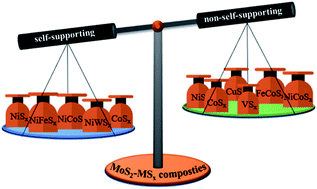Interface engineering of transitional metal sulfide–MoS2 heterostructure composites as effective electrocatalysts for water-splitting
Abstract
Benefiting from the high electrochemical surface area brought by the 2D nanosheet structure, MoS2 has received great research attention for the hydrogen evolution reaction (HER). Recently, it has been demonstrated that by constructing a transitional metal sulfide–MoS2 heterostructure, the HER performance of the MoS2-based catalysts can be further improved. It is even possible to obtain bifunctional catalysts for both HER and oxygen evolution reaction (OER) due to the synergistic effect of the different components in the composite, the electronic effect to enable an efficient electron transfer and appropriate binding energy for the intermediates of the electrocatalytic reactions, and the surface defects on the interface of the heterostructures. Herein, we review the recent progress on the construction of the transitional metal sulfide–MoS2 heterostructure for water splitting based on non-self-supporting and self-supporting catalysts. The surface and interface parameters of the heterostructures are discussed in detail to reveal the key roles of the hybrid structures for energy conversion. We also pay special attention to the theoretical simulations based on first principles to clarify the relationships between the electrochemical performance and structure parameters. Finally, the prospects and challenges of the transition metal sulfide–MoS2 heterostructures for water splitting in the future are proposed to prompt the reasonable design of transition metal sulfide–MoS2 heterostructures for full water splitting.

- This article is part of the themed collections: Editor’s Choice 2023: Advancing electrocatalysts for a sustainable future. and Journal of Materials Chemistry A Lunar New Year collection 2022


 Please wait while we load your content...
Please wait while we load your content...